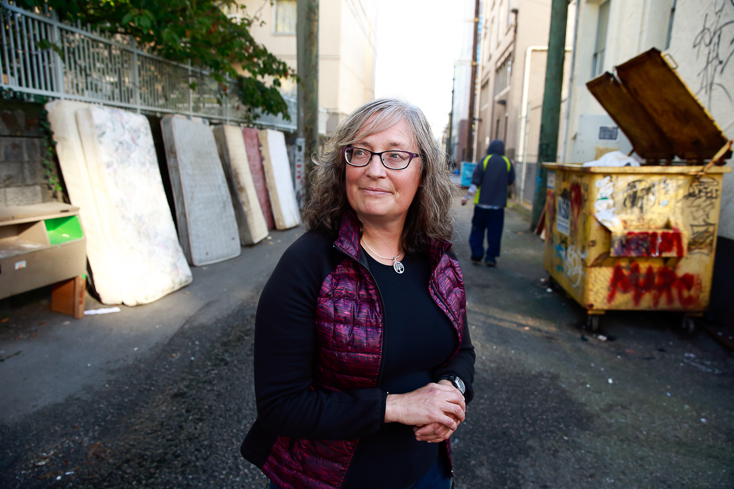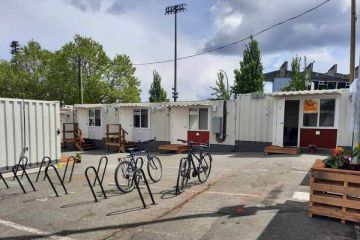No vacancy: how Vancouver housing affordability is impacting homelessness
- Suzanne Ahearne and Jonathan Woods

The relationship between Vancouver’s real estate boom and the crisis of homelessness is more than just a trickle down effect, according to a new report co-written by Centre for Addictions Research (CARBC) researchers Bernie Pauly and Geoff Cross in collaboration with Vancouver's Union Gospel Mission (UGM).
Released with an accompanying UGM video that illustrates the precarious situation of many Vancouver-area residents, the report also suggests homelessness is increasingly beyond an individual’s control.
The report, No Vacancy: Affordability and Homelessness in Vancouver, provides evidence of the correlation between rising housing costs in Vancouver, the diminishing supply of low-end rental housing, dropping vacancy rates and the growing number of people who are increasingly vulnerable to homelessness.
While there have been positive steps taken and growing investments made in homelessness outreach, rent supplements and subsidized housing units, the report’s authors explain the investment is not proportionate to the need in the current environment in Metro Vancouver.
Data from the new report suggest Vancouver is entering a ‘new reality’ in its struggle against homelessness: lack of affordability is driving people onto the streets, creating backlogs in shelters, and preventing others from entering services like addiction recovery.
The report developed out of UGM’s experiences and growing awareness of the difficulties being faced by those accessing their services. UGM provides emergency shelter, housing, alcohol and drug recovery, and education to people struggling with poverty, homelessness and addiction.
In trying to understand and quantify their observations, UGM reached out to Pauly, associate professor with UVic’s School of Nursing . In collaboration with the Greater Victoria Coalition to End Homelessness, Pauly had already developed a community-level framework for monitoring indicators that drive homelessness, and has produced similar reports in Victoria beginning in 2010.
Among the researchers’ principal findings was that increasing market rents and decreasing vacancy rates were occurring especially at the lower end of the rental market—the units most affordable for people at risk of homelessness. In fact, while the number of bachelor suites and one-bedroom apartments in Vancouver has increased modestly over the past five years, the number of units renting at or less than $750 per month has declined; since 2010, supply of these units dropped from 1,728 to 843. The vacancy rate of bachelor suites at this price in the City of Vancouver now stands at a 0.1 per cent.
Other findings from the report corroborate the squeeze at the lowest end of the housing spectrum. While the rental market has become tighter and more expensive over the last five years, the level of financial resources of low-income households has remained relatively stagnant, pushing more people towards social housing, assistance, and out onto the streets. Currently, 10,278 people in Metro Vancouver remain on the BC Housing Registry, seeking suitable housing.
The percentage of women in Metro Vancouver shelters grew from 28 per cent to 32 per cent over the past five years. Low-income seniors have also been hard hit; the number of senior applicants on BC’s Housing Registry has increased by 38 per cent. Meanwhile, occupancy rates at emergency shelters have remained at or above 97 per cent over the last four years. This means there is very little available space in emergency shelters for those in need.
“The question is not whether we are doing something but whether we are doing enough,” Pauly says. “When we look at the current numbers of people who are homeless, the answer is no. Sadly, this makes the job of moving off the streets difficult and has the potential to push people into homelessness.”
Pauly has observed similar dynamics at play in Victoria, having identified this in reports for the Greater Victoria Coalition to End Homelessness.
“Victoria shelters have routinely been running at over 100-per-cent capacity, market housing is unaffordable and unavailable to people on low incomes and social housing has long waiting lists,” says Pauly. In Victoria, the hope is that this trend will change given the recent investment of $60 million (by CRD and the Province of BC) into a Housing First Strategy.”
In a BC Globe and Mail op-ed Pauly and UBC colleague Penny Gurstein advocate for several things: the inclusion of people with experience of homelessness in government policy-making to ensure that all housing needs are considered; an immediate increase in income assistance rates and abolishment of time limits on rent supplements; and a national housing strategy that addresses the full range of housing affordability. This situation requires a municipal, provincial and federal policy response, the authors say.
UGM’s Derek Weiss also contributed to the report, which can be found, along with a video and data supplement, at ugm.ca/affordability.
Photos
In this story
Keywords: homelessness, Canadian Institute for Substance Use Research
People: Bernie Pauly, Geoff Cross




